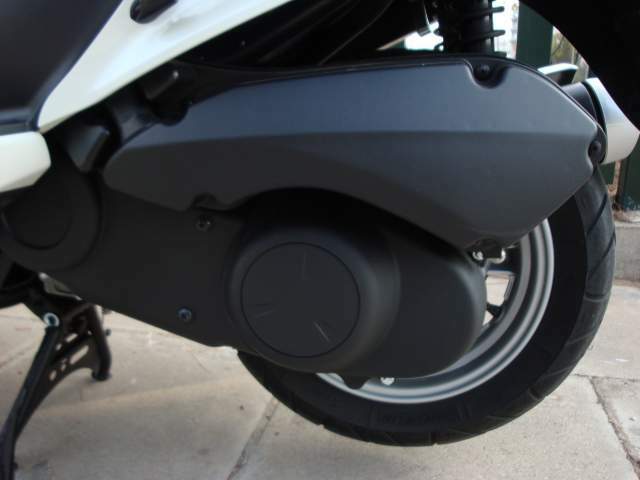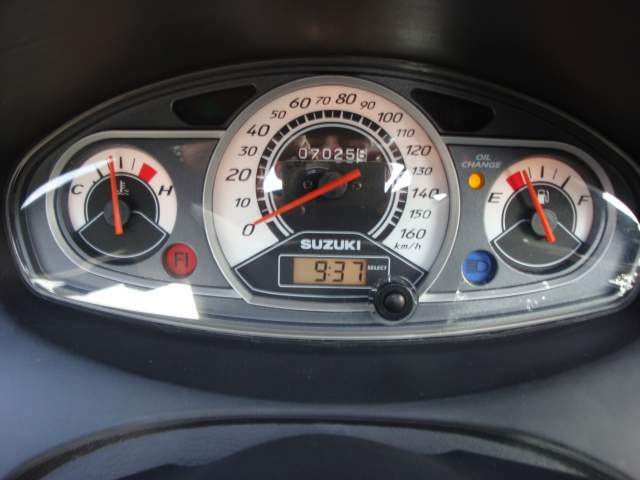Suzuki AN 200 Burgman

|
Make Model |
Suzuki AN 200 Burgman |
|
Year |
2010 - 12 |
|
Engine |
Four stroke, single cylinder,
SOHC, 4 valve |
|
Capacity |
200 cc / 12.2 cu in |
|
Bore x Stroke |
69 x 53.4 mm |
|
Compression Ratio |
11.0:1 |
|
Cooling System |
Liquid cooled |
|
Induction |
Electronic injection |
|
Ignition |
Electronic, transistorised |
|
Starting |
Electric |
|
Max Power |
13.5 kW / 18.35 hp @ 8000 rpm |
|
Max Torque |
17 Nm / 1.73 kgf-m / 12.5 ft-lb @ 6000 rpm |
|
Transmission |
CVT |
|
Final
Drive |
Belt |
|
Front Suspension |
Telescopic, coil spring, oil damped |
|
Rear Suspension |
Swingarm type, coil spring, oil damped |
|
Front Brakes |
Single 220mm disc, 3 piston caliper |
|
Rear Brakes |
Single 220mm disc,1 piston caliper |
|
Front Tyre |
110/90-13M/C 56P, tubeless |
|
Rear Tyre |
130/70-12 62P, tubeless |
|
Dimensions |
Length: 2055 mm / 80.9"
Width: 740 mm / 29.1"
Height: 1240 mm / 48.8" |
|
Wheelbase |
1465 mm / 57.7" |
|
Ground Clearance |
130 mm / 5.1" |
|
Seat Height |
735 mm / 28.9" |
|
Dry Weight |
149 kg / 328 lbs |
|
Wet Weight |
160 kg / 353 lbs |
|
Fuel Capacity |
11 Litres / 2.9 US gal |
|
Review |
Moto-Choice |
Riding position:
The seat height is very low, 735 mm, it will be adequate for quite short riders
also. The support for the back creates a stop at the rider’s place on the seat,
the room for the pillion is also large. The length of the Burgman is increased,
the same applies to the width of the scooter, just at the area of the leg
shield. Burgman’s bulk is close to that of the large scooters, which is
counteracted by the low weight as it will be described later on. Rider feels
being placed rather in than over the scooter.
Due to the handlebar being extended backwards, rider’s arms form a right angle.
Rider’s feet also form an acute angle due to the high floor, even when rider’s
legs are placed at the very front of the floor. Thus riding like this will be
rather inconvenient to tall riders. If rider’s legs are stretched at the space
provided on the leg shield, riding position is comfortable for travelling, its
not convenient though for commuting.
The weight of the scooter is low, 160 Kgs nominal curb, which is indicative for
the small engine displacement. Due to the low saddle, the weight will not result
in an issue, even for quite short riders. Compared with scooters featuring about
the same bulk and a larger engine, the difference in weight is remarkable.

On the road:
The fork and the two shock absorbers at the rear, feel relatively soft. The
spring preload at the shocks is the only adjustment for the rider. Factory
fitted tyres are Michelin Pilot Sport SC with dimensions 110/90-13 at the front
and 130/70-12 at the rear. This rubber is good for the specific scooter, its not
the best choice though.
In town the little Burgman is a really adequate scooter for ordinary rides.
Stability is great, which suits more to the bulk of the scooter, than to the
wheel dimensions or engine capacity. Thus stability feels superior to agility
when riding. The comparatively low weight to what someone would expect from a
bulky scooter, will be helpful when commuting.
Comfort over street imperfections is good, better than average due to the small
wheel dimensions, up to a certain degree of course. Naturally, Burgman will not
absorb any pothole on the streets! Additionally if rider wishes to apply some
weight at his feet in order to alleviate the vibration prior to a large bump,
due to the riding position, it will be almost …impossible.
At the process of filtering the height of the handlebar and mirrors is the same
with that of car’s and SUV’s mirrors. This is not a problem though, due to the
small width of the scooter.
Steering lock is relatively good concerning an urban scooter. In case of traffic
jams, combined with the increased scooter’s length, it will ask for compromises
if the scooter has to be maneuvered around cars. Ground clearance will be
adequate for small pavements, only.
On B-roads, stability is the key element. Agility will be helpful, although it’s
still inferior. Rider will be confident at a higher riding pace, the scooter
will provide relatively good feedback, despite the small wheel dimensions.
On the highway the scooter will be adequate for short trips, since the engine
barely provides the confidence and the safety e.g. for an overtake at normal
highway speed. Cruising at a speed of 110 Km/h or higher, air resistance will be
felt mostly at the shoulders.
Brakes are combined. A 220 mm disc brake and a three piston caliper is equipped
at the front, a 220 mm and a single piston caliper is equipped at the rear. Both
brakes provide adequate initial bite. The front provides average stopping power
and feedback. On low friction factor streets on emergency braking, the front
wheel may be locked, often tending to slide at either side.

On the contrary the rear brake provides good stopping power and feedback, diving
the front and rear of the scooter. This is the result of the combined brakes:
Applying the rear, one out of the three pistons at the front brake caliper is
also activated. Rider will soon adapt applying the rear brake mostly, especially
on low friction factor roads.
Model history/reliability/quality build:
It was introduced in 2002. In 2007 it was equipped with combined brakes. In 2014
ABS was added.
Quality build is really good. Its obviously a luxurious scooter. North countries
need some extra caution concerning corrosion.
Comments:
The floor isn’t flat. Two full face helmets may be stored under the seat, there
is also some free space left around. An internal light is also provided. The
gloves compartment at the leg shield is spacious and deep, it is divided into
two parts, a 12V socket is also provided. At the top right side of the leg
shield, a deep compartment is provided, which will be adequate for a mobile
phone and coins. The plethora of storage spaces is established with a 37 l top
case, adequate for an extra full face helmet.
Α centre and a kick stand are provided. In order to lift the scooter on the
centre stand, some considerable effort is required by the rider initially. If
the fuel level is low, the oil change light will be turned on. The fuel level
indicator still drops. As soon as the bottom of the scale is reached, the
scooter will run out of breath after about 1 Km.
The finish at the top of the screen is thin, it will not distort rider’s view.
The design of the headlamp is unique. Looking at the front of the scooter from
either side, one can see through the headlamp lens. The indicators are rather
protruding, they seem to be vulnerable in case of a crash. Lights are powerful,
the dash light is white, which makes the dials look even more conventional at
night.
The attraction of car owners to the scooters’ field is enhanced by optional
polished bumpers at the front and rear of the scooter. Riders with this kind of
fresh background are the only ones who may feel safety and familiarity with
equipment like that. Strictly in terms of design, they don’t look bad.
Additionally the huge rear lights, derive from the auto industry design.
A smaller 125 c.c. version is also produced, weighting 159 nominal Kgs curb,
that is just 1 Kg less than the 200 c.c. Burgman. In Japan the Burgman series is
sold as Skywave, a much more fascinating name. Despite the Burgman name for the
whole range of Suzuki’s large scooters, the smaller 125-200 c.c. members of the
family are provided with a different model code (UH) instead of the bigger
brothers, (ZA). Two versions for the small Burgmans are available, a plain one
and the Executive. The differences are located to the screen, Executive’s
smarter dash, black wheels, a white stitch at the saddle and a faint blue
headlamp glass.
Conclusively Burgman 200 is a stable, agile and luxurious scooter which targets
riders deriving from the car sector. Due to the engine displacement its much
lighter than the bigger brothers of the family.
|
